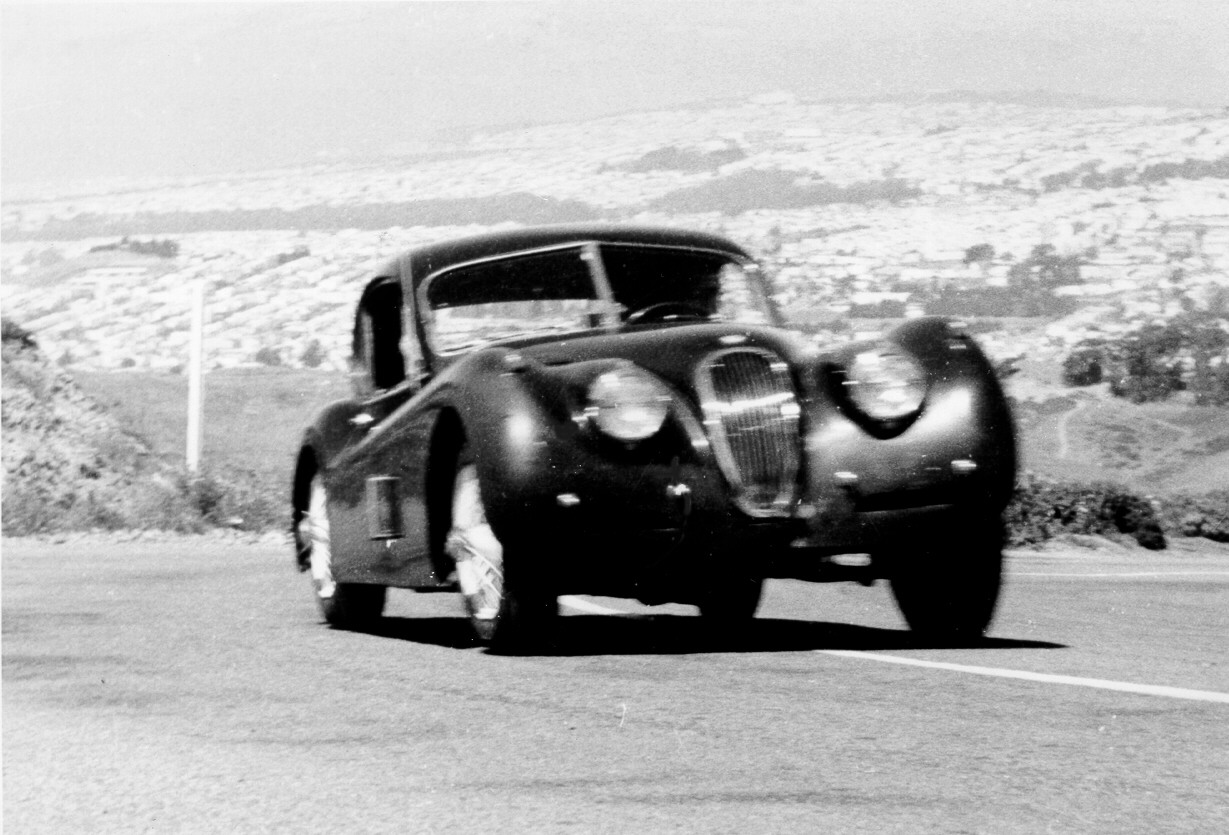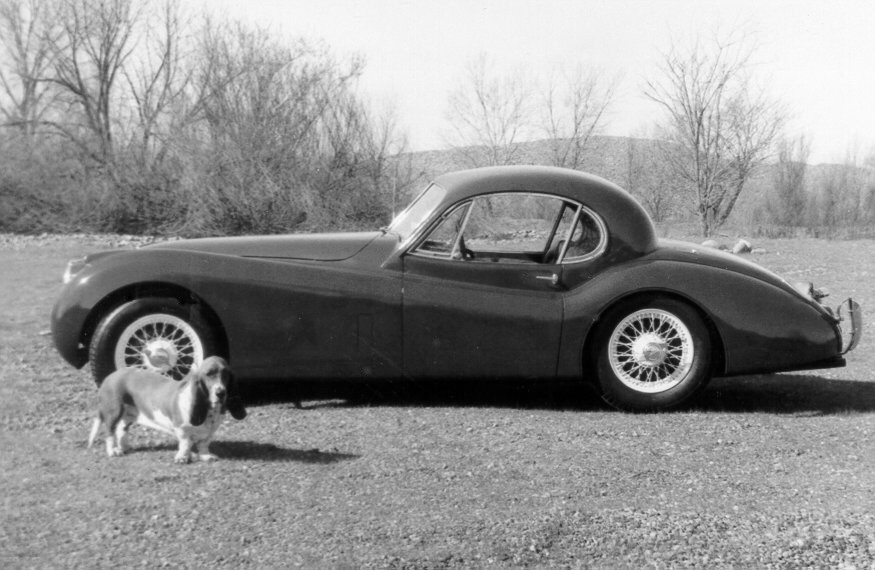|
Sorry, there are no color photos of this car.
It was dark (British Racing) green with white wheels.
This Jaguar was my very first car! It
was one of 2,484 left hand drive Fixed Head* Coupes built. It had been
driven pretty hard, heck abused is more like it, before I bought it, but it looked great to me. It ran, handled and stopped
well enough, and I had saved enough money to buy it. Nearly every mechanical part of the car broke except the Moss
transmission. The Moss gearbox, or transmission as we Americans call
them, was not state-of-the-art, even for the late 50s - fast shifts always
resulted in a loud "grunch", and first gear wasn't synchromesh.
I learned how to double clutch into first gear while moving which gave me a
great feeling of accomplishment. I had a lot of fun with this car
and I learned a lot. It set the tone for all my sports cars that
followed. In the beginning of my quest for a sports car, my budget was
such that I was thinking about buying an MG TD, a car that looked like it
belonged in the 1930s. David quickly talked me out of an MG by saying
that I would tire of the lack of power; only 57 bhp and a top speed of less
than 80 mph! A Jaguar by comparison had 160-180 bhp, depending on the
model, and was supposed to be good for 120 mph, hence it's name, XK120.
I quickly switched my allegiance to Jaguar, especially since Dave not only
recommended I get one, but also because he was racing one and I spend a lot of
time in his garage familiarizing myself with their mechanicals, in fact
everything I could about them.
* The English use different terms for their
cars than we do. The roof, or top of the passenger compartment is
called the head - fixed head is a hardtop, and a drop head is a
convertible. Our hood is their bonnet, fenders are wings, and the
trunk is called the boot. They also refer to "nearside" and "farside"
which is stamped on the left side and right side knock-off wheel nuts.
The car was brand new to me when these
three photos directly below were taken. My mom worked at a
camera store and was able to take loaner cameras home on weekends.
These were taken with an amazing new Polaroid bellows camera.



Jaguar shocked the world
when it introduced the XK120 at the Earl's Court Auto Show in 1948.
The Dual Over Head Cam inline 6 cylinder engine was a technical tour de
force. The engine was originally conceived to power a four door
saloon (sedan), but that car wasn't ready, so the XK120 roadster was rushed into
production as a vehicle to showcase the engine. The 120 in the name
signified the car was capable of 120 mph. The fixed head coupe came
along in about 1952, followed in 1953 by the drop head coupe.
Sometime during the summer of
1960, my first year of ownership, my friend Chris "Kit" Latham and I
drove up on Twin Peaks in San Francisco and took these shots. Notice the photo
on the left. The car is cornering at a pretty good clip, you can see the
right front tire bending under the rim, and the body roll is quite
noticeable. Judging by the open vent on the right fender, it must have
been warm that day in San Francisco.




Notice the "backward" tach - the pointer moves
counter-clockwise as revs go up

Sadly, that first carefree summer of
ownership was marred by the first of many problems I would encounter.
On the second day my dad and I went to see some cousins on the
Peninsula. On the way home as I got on 101 and accelerated
through the gears, the clutch driven disc came completely apart.
We got it towed home by borrowing Dave's tow bar and I performed
my first repair job. On this car, the transmission can be
removed by removing the seats, floor boards, and the transmission
tunnel. That made it relatively easy, working from the inside of
the car. The previous owner helped me out by paying for the
clutch disc.
Another failure occurred when I was heading home from Beale Air Force
Base to San Francisco. Traffic slowed near Vacaville. I
geared down in good sports car fashion and suddenly had a bad miss.
I made it to home, and removed the cam covers. I discovered a
lot of broken valve springs and one broken cam follower, caused by the
downshift I had made. In its weakened state, a valve floated and
broke the follower. I bussed it to the base for awhile while my
car's head was reconditioned at the local BMC dealer.
I broke both axle shafts, one part Dave never breaks on Jags.
Ha! They broke at different times, under normal acceleration, I
wasn't "beating" on the car any time I broke something. I
remember Dave neatly lassoing the broken stub of one axle with a piece
of safety wire in order to remove it from the axle housing without
having to dismantle the entire assembly. Dave was not only
my hero, he was my savior. Jaguars were notorious for
overheating, and I had my share since I was stationed in the Central
Valley of Calif. Trying to cure the overheating problems, I
rebuilt the 19th Century style water pump twice before replacing the
entire pump with a much more modern design pump from an XK140 - that
fixed that problem. Winters in San Francisco presented no cold
starting issues, but it was cold enough at the base to be very
reluctant to start on cold mornings. I wired up the disconnected
electric starting carburetor with a toggle switch I scored from the
Air Force. Cold morning starts were no problem, and I had that
characteristic Jaguar hiss until the engine was warm enough to run
without the starting carb. Like I said, I learned a lot about working
on cars, and working on Jaguars in particular with this car. I
almost wish I had it back, in pristine condition, of course.
I would be remiss if I neglected to mention Dave's private road race
course in the City. KRON which used to be channel 4 was alone in
using a transmitting tower in the San Bruno mountains just south of
San Francisco. A road led to the top where the station engineers
staffed the equipment - nobody else ever seemed to use the road.
By driving out Mission Blvd. to Crocker St., and turning left or East
onto Crocker, you would eventually end up on the road to the top.
It was nicely paved, and had varying elevation and curves, some smooth
and fast, others quite tight and closely spaced together. At the
bottom once out of civilization, was a large white square painted on a
huge eucalyptus tree, and at the top, just before entering the parking
lot was a white circle painted on a rock on the bluff beside the road.
The drill was to drive up to the top at a moderate speed to see if
anybody was driving around. Usually the only cars (one or two)
seen were parked at the transmitter. Then you would return to
the bottom, and with your passenger using a stop watch, make a running
start, with the time starting as you passed the marked tree.
Driving as fast as one dared, make a mad rush to the top. I
don't remember any of the times now, and my times were certainly a lot
slower than Dave's. Dave even rode along with me one time and
critiqued my driving when we reached the top. I remember most
vividly the part where I was fastest was the sweeping curves where I
could feel the back end of the Jag hanging out in a nice controlled
power slide. For another speed contest story,
go here.
The next summer, 1961, I decided to overhaul the engine
because it was very tired
and burned a prodigious amount of oil. My mentor and hero Dave
scored some 3.8 litre pistons that had come out of a D Type Jaguar
that finished 2nd or 3rd, or something at Sebring. I removed the
engine in my parents garage and with Dave's help, tools, and guidance
overhauled the bottom end. For example, the chain fall in the
picture is Dave's, as were the A frames to support Dave's 4X10 beam.
Then were was the torque wrench, and all the other tools I didn't
have. He took the time to measure the crank with his micrometer
so I knew it was in fine shape and that standard copper-lead bearings
would be the ones I needed. I had a service manual for
reference, but Dave was the brains behind my getting the engine back
together and running like a Swiss watch!
Oh year, the added cubic inches and fresh
rings gave a significant improvement in performance - 0-60 in
7.0 seconds. That sounds slow today, but it was very respectable
in 1961. The road test car cited below took 8.5 seconds and it
had a 3.77 rear end, compared to the 3.50 in my car which would tend
to make it slower.
Click for a Road & Track
Road Test of a XK120 Jaguar

I'm sorry to say this is the only photo
I have of that eventful task
One day without warning the Air Force
changed their policy and would no longer let the car on base without
front bumpers. I had to scramble and hitch rides to work until I
found a place that made the nerf bars. It was like a blacksmith
shop, but the guy was pretty handy the way he fitted them to the car.
Getting them, them chrome plated was pretty simple. The Air
Force was happy and let the car back on the base and so was I.
The photos directly above were taken after I had installed nerf bars
to replace the missing front bumpers and had the car repainted the
same 'British Racing Green' as before. Midge our Bassett Hound
is on guard!
That grill with the fne vertical teeth was replaced with a stamped
part on the next model. This grill was labor intensive to build
and difficult to keep the bars straight.

Sporting my fancy new nerf bars

Bassett Hound Midge stands guard

The new black and yellow 60s license
plates
In 1963 all the shortcomings of this ten year old car got the best of me
and I traded it in on a fancy new American car with bucket seats, a center
console and four on the floor, a Ford Galaxie 500 XL. It was nice
but boring and two years later I got rid of that in favor of my
Mustang
which was much closer to a sports car then the Ford.
|